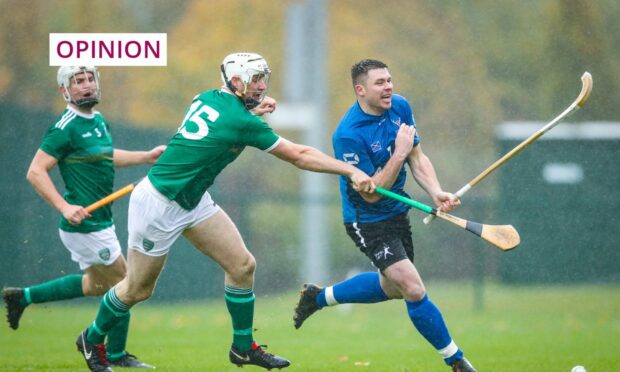While many will be focused on the Rugby World Cup in France, an older sport takes centre stage in Inverness tonight.
Eden Court theatre, the largest performance venue in the Highlands and islands, will be hosting Hugh Dan’s Final Fling. It is a special event marking the official retirement from sports broadcasting of Hugh Dan MacLennan.
Tomorrow, this son of Caol to Hebridean parents (Harris and Scarp) will be behind the microphone for one last shinty encounter. Appropriately, it will be at the sport’s showpiece event, the Camanachd Cup Final on the Highland capital’s Bught Park – Kingussie v Oban Camanachd.
It is the end of an era for the former teacher of Gaelic, P&J and BBC news journalist, CalMac director of communications and, latterly, university tutor. Hugh Dan himself turned out for the Fort William, Glasgow University and Inverness shinty teams.
He has commentated on football, rugby, curling and orienteering in Gaelic and English, but most associate him with shinty. Hugh Dan has been the BBC’s “voice” of the sport since he took over from the late John Willie Campbell in 1991. He has written widely on the game, not least his doctoral thesis from the University of Aberdeen on the sport’s history.
In 1993, his well-received volume – imaginatively entitled Shinty! – was published to mark the centenary of the Camanachd Association. But the game is a deal older.
Rugby may have originated during a game of football at the Warwickshire school of that name in 1823. But shinty arrived in Scotland with the appearance of Gaelic from Ireland in the sixth century AD, or even earlier. The sport featured in the Red Branch cycle of Celtic tales and legends, dating to the first century AD.
Cu-Chulainn, the great hero of the cycle, came over from Ireland to Dun Sgathaich Castle in the south of Skye to learn feats of arms from the warrior queen, Sgathach. But he also found time to defeat the entire Sleat Iomain (shinty) team single-handedly.
The first Camanachd Cup Final in 1896 was also held in Inverness, but not at the Bught. In 1924, the first full international Ireland v Scotland game was played in Dublin using compromise shinty/hurling rules.
What remains extraordinary today is that not only do small, sometimes tiny, communities keep a team going, never mind two or more in different age groups, but they dominate. A glance at the Mowi Premiership placings this morning will show Kingussie top, with their great local rivals Newtonmore in second place. But these Badenoch giants of the game only have around 2,500 residents between them.
In third place is Kyles Athletic from Tighnabruaich, population around 700. Kyles has the same points as Caberfeidh, in fourth place, who play at the edge of Strathpeffer (1,500 people). Lovat is fifth. Its home village of Kiltarlity has a population of around 1,000.
Small communities get the best results
Oban Camanachd is the highest placed team (sixth) from a sizeable settlement of around 9,000 residents. Its reserve team play as Lochside Rovers. But Oban supports two clubs, with Oban Celtic playing in the National Division, below the Premiership. One of its most important players is unavailable just now, as golfer Bob MacIntyre is preparing to play in the European Ryder Cup team.
Then comes Kinlochshiel, which draws from several small communities: Balmacara, Dornie, Kyle of Lochalsh and Plockton. The last two are the largest, with 600 and 400 residents respectively.
Skye is in eighth place. Its home of Portree has 2,300 residents. Then comes Beauly with 1,400. The only city-based team, Glasgow Mid Argyll, is bottom. The team from the biggest Highland settlement, Inverness, sits two divisions below and has only won the Camanachd Cup once, in 1952.
New teams have been founded, mostly recently Uddingston in 2019. Meanwhile, women’s shinty has grown enormously with 20 clubs now turning out around 36 teams.
Hugh Dan’s Final Fling will highlight shinty’s cultural context
Every Saturday afternoon, the equation which normally relates population size to teams’ sporting success and survival is turned on its head, from Bute to Ballachulish, Cannich to Inveraray, Glendaruel to Inverarnie. It should be important to Scotland that it is these small, historically Gaelic-speaking communities which prosper in a game that goes back to the language’s arrival. Back to Cu-Chulainn, if he actually existed.
It is, therefore, fitting that this cultural context is reflected at Eden Court tonight. Included in the line-up is the internationally acclaimed musician Julie Fowlis. Hers is the voice of Scottish Gaelic for the United Nations Declaration of Human Rights Project, which aims to record the declaration in every language in the world.
The “Ceilidh King” Fergie MacDonald and piping legend Duncan MacGillivray of Calrossie will be there. So too will renowned Gaelic singer Arthur Cormack. Host for the evening will be Gary Innes of supergroup Manran, BBC Radio Scotland’s Take the Floor, and formerly of Fort William Shinty Club.
It is just possible that Hugh Dan might say a few words himself.
David Ross is a veteran Highland journalist, author and a supporter of Community Land Scotland


